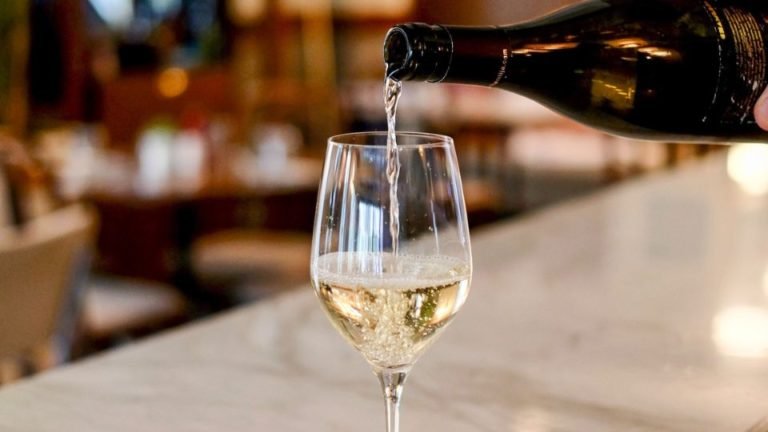Sparkling wines are super versatile. More than any other style of wine. Not quite sure which wine to serve with the dish you’re preparing? When in doubt: opt for a sparkling wine – it’s hard to go wrong.
It may not be 100% true of course, that may be down to taste (although some DO swear by Champagne and steak!) but when it comes to pairing food with wine, bubbly will often trump any other wine you could serve. Read on to discover 5 reasons why sparkling wines work wonders with a variety of dishes.
1 – Sparkling wines have relatively high acidity
Sparkling wines have high acidity which has a mouth-watering effect on the palate (bite into a lemon and you’ll know what we mean). Acidity – and the saliva it produces – forms a perfect contrast to salty, fatty and oily foods, ‘cutting’ through them and leaving your palate feeling refreshed.
2 – Sparkling wines have bubbles
We might be stating the obvious but the effervescence – the sparkle, bubbles, perlage or whatever you want to call it, essentially amplifies the palate-cleansing effect of the wine.
This makes them perfect for foods that feel a little greasy, sometimes cloying: from fried chicken to pizza, and from rich sauces to puff pastry – and a far better choice from a smooth red.
3 – Sparkling wines have a moderate alcohol content
The low to medium alcohol content of sparkling wine makes these wines easy to balance with seafood and vegetable dishes compared to oak-aged whites or even light-bodied reds.
With moderate alcohol (c12%) the wine is not likely to become overpowering meaning there’s more chance you’ll see the end of the bottle – without a hangover because who has time for that?!!
4 – Sparkling wines have a varying degree of sweetness
Remember point 1? Sometimes you don’t even notice that a sparkling wine has such high acidity because of the dosage. The what? Dosage is a mix of still wine and sugar which gets added to sparkling wines (made in a traditional method) to balance off the acidity so sometimes you don’t even realise it’s doing the job of cleansing your palate.
It’s hard to believe that virtually all sparkling wine used to be made in a (very) sweet style. These days there’s a tendency towards wines that are bone dry but you’ll still find some sweeter versions around. Here’s what you need to look for on the label to understand just how sweet they are:
- Extra brut (0-6 grams/litre), Bone dry
- Brut (0-12 grams/litre), Dry to very dry
- Extra sec or Extra dry (12-20 grams/litre, Dry to medium dry
- Sec or Dry (17-35 grams/litre), medium to medium sweet
- Demi-sec (35-50 grams/litre) sweet – save these for desserts
- Doux (>50 grams/litre), very sweet
5 – Sparkling wines are just more fun
Who started a celebration with a robust red? That’s right – no-one! Sparkles just add a touch of something special to a meal. And these days, being together and enjoying each others’ company is something to celebrate.
Sparkling wine is so versatile exactly because there is an incredible range of styles available which means that they shouldn’t just belong in aperitif and can be served from the beginning to the end of a meal. From a floral Prosecco to a vintage Champagne, bubbles are there to make any meal memorable. Here are a few that are very different and a fabulous addition to any meal:
Metodo ancestrale for a casual start: The ‘ancient method’ for getting the bubbly in the bottle, Phermento is a bone dry, sparkling Lambrusco that is fabulous with pizza, finger foods and even tempura.
Prosecco: Cuvée du Boj is our absolute favourite Prosecco. It’s relatively dry, flora and bursting with aromas of pear and apple. Try it with baked fish, pasta with pesto, octopus salad, and most light dishes.
Metodo Classico for a bit more oomph: Made with the same method as Champagne (with the second fermentation in the bottle), we love the Blanc de Blancs from Borgo Maragliano that pairs fabulously with seafood and fish dishes, but also creamy pastas and risottos.
And to finish… Moscato d’Asti: A perfumed, light-bodied sweet sparkling wine, moscato is great for desserts that are not overly sweet (fruit or nut-based), a slice of panettone but can even pair magnificently with … oysters! The moderate sweetness contrasts with the saltiness to make an unusual pairing but one which works. The Moscato from Vietti has a lot of depth and interesting aromas to it.
Here are some bubble and food combos you might want to give a try:
- Truffled Popcorn & Blanc de Noirs (champagne made with Pinot Noir grapes)
- Fried chicken & Cava
- Indian curry & Vintage rosé Champagne
- Mature cheeses (aged cheddar, Parmigiano Reggiano) with Vintage Champagne
- Roasted Hazelnuts & Brachetto
What’s your favourite? Leave us a comment.

Leave a Reply